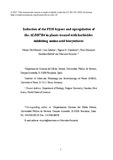Mostrar el registro sencillo del ítem
Induction of the PDH bypass and upregulation of the ALDH7B4 in plants treated with herbicides inhibiting amino acid biosynthesis
| dc.creator | Gil Monreal, Miriam | es_ES |
| dc.creator | Zabalza Aznárez, Ana | es_ES |
| dc.creator | Missihoun, Tagnon D. | es_ES |
| dc.creator | Dormann, Peter | es_ES |
| dc.creator | Bartels, Dorothea | es_ES |
| dc.date.accessioned | 2017-09-13T07:33:49Z | |
| dc.date.available | 2019-11-01T00:00:11Z | |
| dc.date.issued | 2017 | |
| dc.identifier.issn | 0168-9452 (Print) | |
| dc.identifier.issn | 1873-2259 (Electronic) | |
| dc.identifier.uri | https://hdl.handle.net/2454/25561 | |
| dc.description | Incluye 3 ficheros de datos | es_ES |
| dc.description.abstract | Imazamox and glyphosate represent two classes of herbicides that inhibit the activity of acetohydroxyacid synthase in the branched-chain amino acid biosynthesis pathway and the activity of 5-enolpyruvylshikimate-3-phosphate synthase in the aromatic amino acid biosynthesis pathway, respectively. However, it is still unclear how imazamox and glyphosate lead to plant death. Both herbicides inhibit amino-acid biosynthesis and were found to induce ethanol fermentation in plants, but an Arabidopsis mutant deficient in alcohol dehydrogenase 1 was neither more susceptible nor more resistant than the wild-type to the herbicides. In this study, we investigated the effects of the amino acid biosynthesis inhibitors, imazamox and glyphosate, on the pyruvate dehydrogenase bypass reaction and fatty acid metabolism in A. thaliana. We found that the pyruvate dehydrogenase bypass was upregulated following the treatment by the two herbicides. Our results suggest that the Arabidopsis aldehyde dehydrogenase 7B4 gene might be participating in the pyruvate dehydrogenase bypass reaction. We evaluated the potential role of the aldehyde dehydrogenase 7B4 upon herbicide treatment in the plant defence mechanism. Plants that overexpressed the ALDH7B4 gene accumulated less soluble sugars, starch, and fatty acids and grew better than the wild-type after herbicide treatment. We discuss how the upregulation of the ALDH7B4 alleviates the effects of the herbicides, potentially through the detoxification of the metabolites produced in the pyruvate dehydrogenase bypass. | en |
| dc.description.sponsorship | Miriam Gil-Monreal received funding from fellowships through Universidad Pública de Navarra. This work was financially supported by two grants from the Ministerio Español de Economía y Competitividad (AGL-2013-40567R and AGL-2016-77531R). | en |
| dc.format.mimetype | application/pdf | en |
| dc.format.mimetype | application/zip | en |
| dc.language.iso | eng | en |
| dc.publisher | Elsevier | en |
| dc.relation.ispartof | Plant Science 264 (2017) 16-28 | en |
| dc.rights | © 2017 Elsevier B.V. The manuscript version is made available under the CC BY-NC-ND 4.0 license. | en |
| dc.rights.uri | https://creativecommons.org/licenses/by-nc-nd/4.0/ | |
| dc.subject | Acetohydroxyacid synthase | en |
| dc.subject | 5-enolpyruvylshikimate-3-phosphate synthase | en |
| dc.subject | Ethanol fermentation | en |
| dc.subject | Fatty acids | en |
| dc.subject | Glyphosate | en |
| dc.subject | Imazamox | en |
| dc.title | Induction of the PDH bypass and upregulation of the ALDH7B4 in plants treated with herbicides inhibiting amino acid biosynthesis | en |
| dc.type | Artículo / Artikulua | es |
| dc.type | info:eu-repo/semantics/article | en |
| dc.contributor.department | Ciencias del Medio Natural | es_ES |
| dc.contributor.department | Natura Ingurunearen Zientziak | eu |
| dc.rights.accessRights | Acceso abierto / Sarbide irekia | es |
| dc.rights.accessRights | info:eu-repo/semantics/openAccess | en |
| dc.embargo.terms | 2019-11-01 | |
| dc.identifier.doi | 10.1016/j.plantsci.2017.08.003 | |
| dc.relation.projectID | info:eu-repo/grantAgreement/MINECO//AGL2013-40567-R/ES/ | en |
| dc.relation.projectID | info:eu-repo/grantAgreement/ES/1PE/AGL2016-77531 | en |
| dc.relation.publisherversion | https://doi.org/10.1016/j.plantsci.2017.08.003 | |
| dc.type.version | Versión aceptada / Onetsi den bertsioa | es |
| dc.type.version | info:eu-repo/semantics/acceptedVersion | en |
| dc.contributor.funder | Universidad Pública de Navarra / Nafarroako Unibertsitate Publikoa | es |



